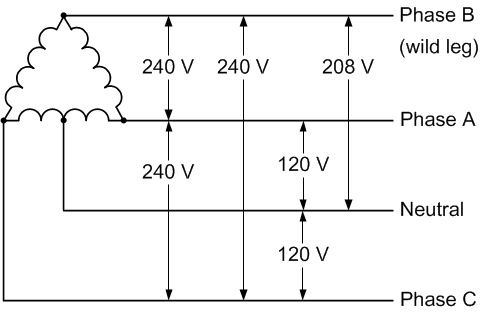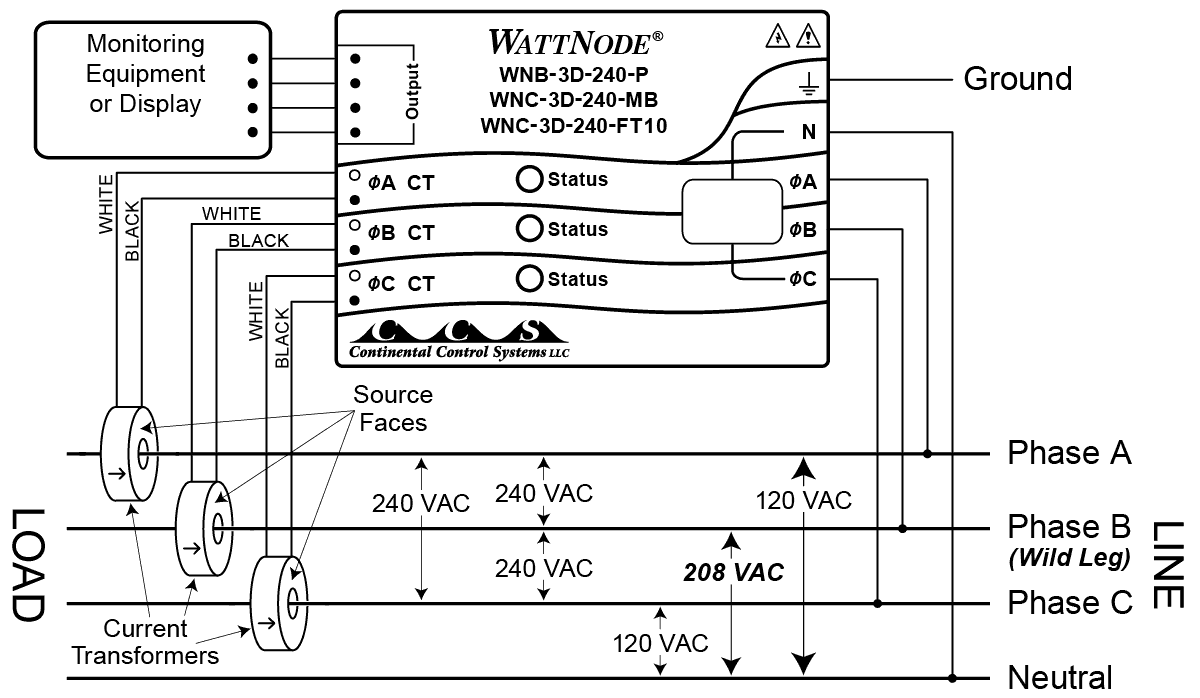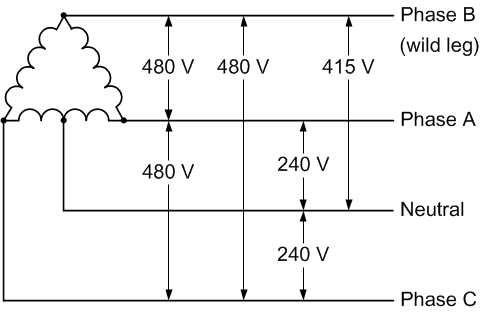A four-wire delta (4WD) electrical service is a three-phase delta service with a center-tap on one of the transformer windings to create a neutral for single-phase loads. Motors loads are commonly connected to phases A, B, and C, while single-phase loads are connected to either phase A or C and to neutral. Phase B, the “high” leg, is not used for single phase loads.
This type of service, which is also known as a “high-leg”, “wild-leg”, “stinger leg”, or “wild phase” service, is common in older manufacturing facilities with mostly three-phase motor loads and some 120 volt single-phase lighting and plug loads.
Download: Four Wire Delta Service (AN-113) (PDF, 1 page)
120/208/240 Volt Service
| Compatible WattNode Models |
|---|
| Any 240 volt delta (3D) model |
This is the most common four-wire three-phase delta service and is essentially a 240 volt, three-phase, three-wire delta service with one of the 240 volt transformer winding center tapped to provide two 120 Vac circuits, which are 180 degrees out of phase with each other. The voltage measured from this center tapped neutral to the third “wild” leg is 208 Vac.
This service almost always has a neutral connection, but in some rare situations, the neutral conductor is not available. It generally exists at the service entrance, but may not run to the panel or load. In theory, a four-wire delta without neutral is just a three-phase delta, but there is one difference. In a normal three-phase delta, ground will either be the center voltage or one one leg, but a three-phase delta derived from a four-wire delta transformer will have ground halfway between two legs. Delta model WattNode meters are the best choice, as they will work with or without a neutral connection.
240/415/480 Volt Service
| Compatible WattNode Models |
|---|
| Any 480 volt delta (3D) model |
This is much less common, but we do occasionally get requests to measure this type of service, which is essentially identical to a 120/208/240 service, but with all the voltages doubled.
General Notes
- The high-leg or phase with the higher voltage as measured to neutral has traditionally been designated “Phase B”. A change to the 2008 NEC now allows the high leg of a four-wire three-phase delta service to be labeled as the “C” phase instead of the “B” phase.
- The NEC Code requires that the high leg be identified by an orange color (it was often referred to as a red-leg delta) or by other effective means and is usually the “B” phase. However, to accommodate utility meter configurations the high leg is permitted to be the “C” phase where metering is part of the switchboard or panel board. The Code change in this section requires legible, permanent field marking of the switchboard or panel board.
- The CAT III box label on current production WattNode meters says “Ø-N 140V~” (or “Ø-N 277V~“), but the high leg phase-to-neutral voltage will be 208 Vac (or 416 Vac). This is normal and will not harm the meter.
- The phase angles (referenced from neutral) will be A = 0 degrees, B = 90 degrees, C = 180 degrees. This is different from a normal 3Y-208 or 3D-208 circuit where the phase angles are 0, 120, 240 degrees.
- For accurate phase-to-phase (or line-to-line) voltage measurements configure the PhaseOffset parameter as follows:
- For BACnet models set the PhaseOffset object to 3.
- For Modbus firmware version 16 or later, set the PhaseOffset register (1619) to 90.
- With Modbus firmware versions prior to version 16, the phase-to-phase voltage measurements are not accurate, but other measurements will work normally.
- Because of the unusual phase angles, when metering a 4WD circuit with a resistive load, the power factors will be 1.0, 0.87, 0.87. With a motor load, you can get power factors like 0.9, 0.5, 0.0 (or even negative on one phase). You should expect very unbalanced power (kW) readings and varying reactive power from phase to phase. But, if things are wired up correctly, the phase currents should nearly match.
- The average measured power factor may not be accurate for four-wire delta circuits.





